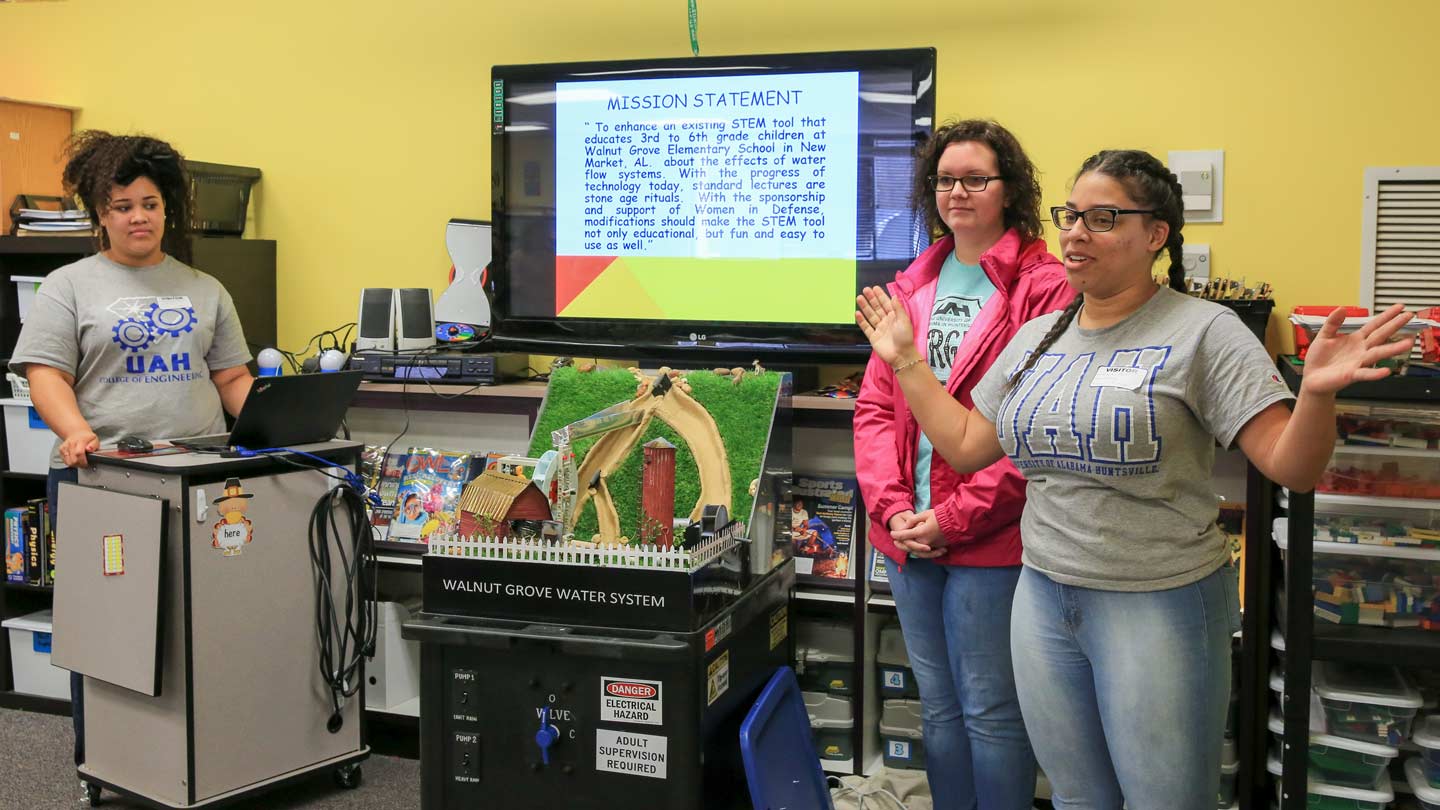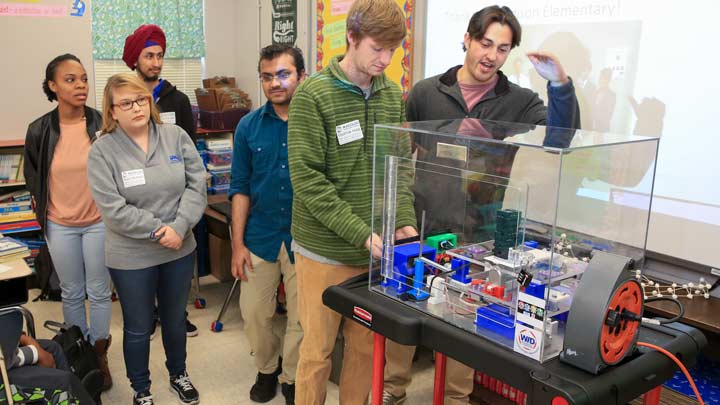
UAH mechanical engineering majors Chermonica Johnson, Rebecca Thomas, and Kimille Trott overhauled a project designed to demonstrate the effects of water-flow systems in a farm environment for students at Walnut Grove Elementary School.
Michael Mercier | UAH
At the start of Dr. Christina Carmen’s two-semester senior design course at The University of Alabama in Huntsville (UAH), students are asked to choose a project from a variety of sponsored options and form groups based on their selection.
"Sometimes I write proposals and seek out funding for projects, but more often than not, real-world customers present their specific needs to me," says Dr. Carmen, a clinical associate professor in the Department of Mechanical and Aerospace Engineering. "If the scale is appropriate for the course, I will have a team work on the design solution."
This year, two teams took on the challenge of designing and building interactive science, technology, engineering, and math (STEM) tools for use at Madison Elementary School and Walnut Grove Elementary School. Both options were sponsored by the Tennessee Valley Chapter of Women in Defense, a long-standing promoter of STEM outreach efforts for local schools.
For Madison Elementary School science teacher Karen Hartselle, the goal was to teach her fifth graders about building structures with enough support to withstand an earthquake. Specifically, she wanted a product that included automated movement of the earthquake simulator surface so that students could refine their building models to endure varying levels of seismic activity. UAH students Derica Taylor, Rafael Solares, Brijesh Patel, William Johnson, T.J. Singh, and LaQuisha Williams rose to the challenge.
It made me realize how important STEM outreach to schools is.
"We wanted to create something that would get young students excited about engineering," says senior mechanical engineering major William Johnson. As the team brought their ideas together, they focused on making the product fun. Patel came up with the idea of using actuators to recreate the shaking motion of an earthquake. Johnson then suggested they swap the polarity of the actuators using adjustable timer relays. This would allow users to adjust the time between strokes to simulate different levels of earthquakes. They also made the entire structure transparent so that the young students could observe how the different components worked. "The best thing about the earthquake simulator is its simplicity," says William Johnson. "It’s kid friendly, hands on, and easy to fix if something breaks down."
For Walnut Grove Elementary School librarian Holly Whitt, the objective was twofold; first, she wanted to inspire an interest in the STEM fields among students at the Title I school, and second, she wanted to sustain their interest by making the effort relevant to the rural community that surrounds it. To meet those requirements, UAH students Chermonica Johnson, Rebecca Thomas, and Kimille Trott were asked to enhance a pre-existing project designed to demonstrate the effects of water-flow systems in a farm environment.
"The team actually had a very difficult task in that they had to refine an existing system," says Dr. Carmen. "It’s often easier to design and build a product from scratch than it is to troubleshoot an existing product." But the all-female team did just that, designing pumps to simulate normal and heavy rainfall, creating magnetic dams that could be used to direct water for flood control, and incorporating mechanical and hydro-powered water wheels to generate electricity for a barn and silo. "We spent two days at Pfeiffer Fire Arts in Elkmont building the waterways, and I have to say, my favorite tool is now a Dremel® rotary tool," laughs Rebecca Thomas. "We got our hands dirty molding the clay, and then we got to use some pretty cool tools to cut the clay and drill holes into it!"
While the teams had a lot of fun building and fine-tuning their products, they also learned the importance of a thorough systems engineering process. Both groups kept in contact with their clients throughout the design process, conducting three reviews during the first semester and three more during the second semester to ensure their products would meet client expectations and state curriculum requirements. Dr. Carmen also invited industry leaders from a variety of fields to act as guest reviewers.

A team of UAH students showcases the “kid-friendly, hands-on” earthquake simulator they designed and built for students at Madison Elementary School.
Michael Mercier | UAH
"These reviews mimic what students will experience down the road when they work for a company," explains Dr. Carmen, adding that guest reviewers consistently comment that her students’ reviews rival, or surpass, the quality seen in the industry.
The value of this kind of real-world experience is not lost on senior mechanical engineering major Chermonica Johnson. "Over the course of the two semesters, we learned how to manage our time better, seek help when needed, and that, no matter how difficult a task, we will NOT give up," she says.
With their completed projects in tow, the groups visited their respective schools in November for a final demonstration. They were met with a lot of enthusiasm and questions from their young customers. "Their main question was ‘When can we use it?’" says Chermonica Johnson of her team’s visit to Walnut Grove Elementary School. "The demonstration of how water can be controlled to improve our lives definitely sparked their interest."
At Madison Elementary School, the fifth graders were eager to show the earthquake simulator team how much they had learned. "I came from a school that was very poor and didn’t really know what engineering was until I started college," reflects William Johnson. "It was encouraging to see a lot of these young students know the answers to our questions. It made me realize how important STEM outreach to schools is."
Deborah Fraley, the STEMi representative of project sponsor Women in Defense, agrees. "The opportunity for elementary and middle school students to see scientific and engineering principles demonstrated by tools they can directly interact with has proven to increase student interest in pursuing higher education and careers in technical disciplines," she says. She also notes that both projects were completed on time, within budget, and in accordance with all performance requirements. Most importantly, the teachers and students were very happy with their STEM tools.
And the pride of seeing another set of teams achieve their goals? That hasn’t diminished in the fifteen years Dr. Carmen has been teaching the course. "There is no greater joy in my job," she says, "than to witness a team deliver a beautiful, high-quality, functioning product to a customer."